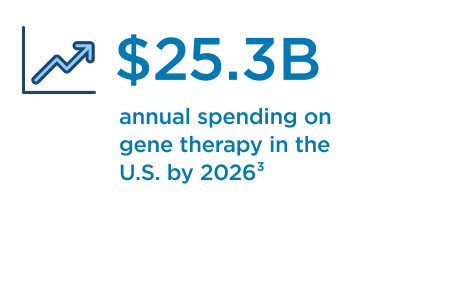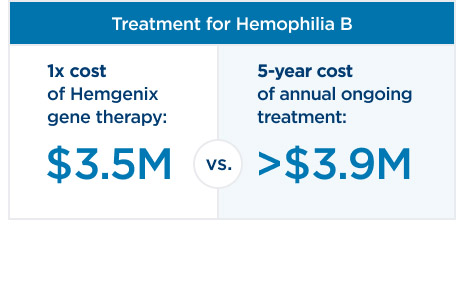ARTICLE
Decoding the high costs and potential impact of emerging gene therapies
Published: January 27, 2025



Gene therapies have revolutionized the treatment of genetic diseases. Primarily one-time treatments, they promise to cure or slow the progression of aggressive, debilitating, and often fatal conditions. Like many emerging health technologies, gene therapies are extremely expensive, with prices as high as $4.25 million for a single dose.1 By 2026, annual spending on gene therapy products and patients in the U.S. is estimated to reach $25.3 billion.2
As an employer faced with continually rising health care costs, the high prices for gene therapies may be alarming. Here, we’ll explore the prevalence of genetic disease, the reasons why gene therapies are so expensive, and the long-term cost-effectiveness relative to other treatments for genetic disease. And we'll also discuss strategies to help you prepare your organization for the future of gene therapies.

What are gene therapies?
Gene therapies treat genetic mutations that cause diseases or hinder the body’s ability to fight them. Rather than addressing the symptoms of the genetic mutation, gene therapies attempt to fix the root cause by modifying the expression of those genes.
Types of gene therapy
- Gene addition: Replacing a disease-causing gene with a healthy copy of the gene
- Gene silencing: Deactivating a disease-causing or malfunctioning gene
- Gene editing: Introducing a new or modified gene into the body to help treat a disease
The U.S. Food and Drug Administration (FDA) approved the first gene therapy in 2017 and has approved 19 as of June 2024.4 They’ve also approved several cell therapies, a closely related treatment of genetic disease. One study estimates there will be between 54 and 74 approved cell and gene therapies by 2030.5
Thus far, clinical trials of gene therapies have shown encouraging results in treating a variety of genetic diseases, including:
- Hemophilia
- Sickle cell disease
- Inherited neurological disorders
- Severe combined immunodeficiency
Many of the diseases that gene therapies treat are rare
The FDA has approved 2 gene therapies to treat sickle cell disease (SCD), which affects approximately 100,000 people in the U.S.6 That figure represents less than 0.03% of the U.S. population. Most diseases treated with approved gene therapies, including those with the highest price tags, are significantly rarer than SCD.
| Genetic disease |
Prevalence in U.S. | Cost of gene therapy |
| Metachromatic leukodystrophy (MLD) |
~ 40 children/year born with MLD7 |
$4.25 million (Lenmeldy) |
| Hemophilia B | ~ 7,000 people8 |
$3.5 million (Hemgenix) |
| Cerebral adrenoleukodystrophy |
~ 50 people/year9 | $3 million (Skysona) |
| Transfusion-dependent thalassemia |
~ 1,400 people10 |
$2.8 million (Zynteglo) |
leukodystrophy (MLD)
adrenoleukodystrophy
thalassemia
leukodystrophy (MLD)
(Lenmeldy)
(Hemgenix)
adrenoleukodystrophy
(Skysona)
thalassemia
(Zynteglo)
Gene therapies have yielded remarkable results
The high cost of specific gene therapies may seem more justified when you consider how transformative they can be. Gene therapies for MLD and SCD, for instance, have radically improved patients’ lives.
Children with the genetic disease MLD lack an enzyme needed to break down fatty substances known as sulfatides that can build up and become toxic to their nerves. Typically, MLD kills affected children before they turn 7. The first MLD patients treated with Lenmeldy, however, have continued to make this missing enzyme for more than 12 years after their treatment.11 Instead of living a short and painful life, they’re developing like other children thanks to gene therapy.
Patients living with SCD have also seen marked improvements from gene therapy. Without gene therapy, they can regularly experience vaso-occlusive crises (VOC), where sickled red blood cells restrict the flow in blood vessels and limit oxygen delivery to the body’s tissues, causing severe pain and organ damage. In one multi-center trial of SCD gene therapy Casgevy, over 93% of patients had improved outcomes for at least 12 consecutive months.12
Of course, other gene therapies have fallen short. Elevidys is the first gene therapy for pediatric patients between 4 and 5 years of age with Duchenne muscular dystrophy (DMD), which can strip children of their ability to walk by their teens and be fatal by age 30. A recent study showed that one year after receiving the one-time treatment, patients on Elevidys improved by 2.6 points on the North Star Ambulatory Assessment (NSAA) scale, while those in the placebo group improved by 1.9 points.13 The difference was statistically insignificant, and the study failed to meet its goal. While this is unfortunate news for DMD patients in the short-term, the results reaffirm why the United States Food and Drug Administration requires rigorous clinical trials of gene therapies: to ensure each gene therapy is safe and effective before it’s approved.
Why are gene therapies so expensive?
Gene therapies are expensive because of the high costs of research and development, clinical trials, and manufacturing. “Gene therapies treat rare diseases, which means fewer people taking the drugs — so the price of each gene therapy must make up for the cost of research and development,” explains Bryce Mendelsohn, MD PhD, a Kaiser Permanente physician specializing in genetics.
Gene therapies may be more cost-effective long term
Though initially expensive, some gene therapies may be more cost-effective than conventional treatments in the long term. For instance, prophylactic factor IX replacement therapy, the conventional therapy for hemophilia B, has a mean annual cost of $788,491 for an extended treatment.14 That cost alone may be concerning, but consider that the cost of this therapy will increase exponentially each year. Though initially staggering, the one-time, $3.5M cost of hemophilia B gene therapy Hemgenix may be more affordable than annual treatment, which could surpass $3.9M in just 5 years.

Few employees will qualify for gene therapy
Given the rarity of the diseases gene therapies treat, it’s unlikely that a high percentage of any business’s employee population would be prescribed gene therapy by their doctor. Gene therapies are also just one of many treatments for genetic disease.
“Before we select someone for gene therapy, we consider the natural course of the disease, the option of alternative treatments, and the efficacy and safety of the gene therapy,” Dr. Mendelsohn explains. “Even if you have a million employees, you're only going to have a couple people a year, at most, who would be considered for gene therapy.”
That said, the cost of a single employee or an employee’s family member who needs gene therapy could be substantial. There is no question that employers must consider strategies around gene therapies that can protect their employees and their bottom line.
How employers can plan for the future of gene therapies
You can play a vital role in safeguarding the health of your employees and their families while helping them and your business mitigate the high cost of gene therapies.
Understand the current landscape
While the high cost and life-changing potential of advancements in gene therapies makes a splash in the media, it’s important to arm your organization with the facts to determine the best approach for your employees and bottom line. Keep in mind that:
- Few of your employees will qualify for gene therapies in the immediate future.
- When prescribed to the ideal candidate, gene therapies can have remarkable outcomes.
- The gene therapy market will expand rapidly by 2030. It’s critical to begin planning for this expansion now.
Discuss your health care partner’s cost containment strategy
Ask your health plan how they contain costs for expensive medications. Your health care partner should have a proactive, evidence-based process for high-cost drugs like gene therapies.
Choose a health care partner with a targeted prescribing approach
Your health care partner should responsibly prescribe gene therapies for the right patients to effectively treat health conditions and achieve desired outcomes. Before prescribing gene therapies, in partnership with the patient, the patient’s care team should consider all avenues of treatment, ensure they are clinically eligible for treatment, and will likely see an improvement.

The future of gene therapies
The number of approved gene therapies and U.S. citizens who need them is going to grow. There are currently over 3,600 cell and gene therapies in the approval pipeline.15 And one study estimates the number of expected people treated with gene therapy or stem cell therapy will amount to over 340,000 by 2030.16
While the expanding field of costly gene therapies may seem like more cause for concern, remember that most of these treatments will be for rare genetic diseases. If you take a proactive role in educating yourself about gene therapies and speaking with your health care partner, you can help prepare your organization for the future of gene therapies.
About our expert
Bryce Mendelsohn, MD, PhD, Medical Director, Prenatal and Reproductive Genetic Carrier Screening Program, Regional Metabolic Clinic
Dr. Mendelsohn graduated from Emory University, Atlanta, Georgia with a B.S. in Biology and Music. In 2010, he received his M.D. and Ph.D. in Molecular Genetics and Genomics at Washington University in St. Louis, Missouri. Dr. Mendelsohn completed residencies at the University of California, San Francisco in Pediatrics and Medical Genetics. Dr. Mendelsohn joined The Permanente Medical Group in 2018 and currently serves as the Medical Director of the Prenatal and Reproductive Genetic Carrier Screening Programs as well as the Regional Metabolic Clinic. His practice is in Oakland, California.
Additional resources you may find helpful



Find the right plan for your business 1-877-305-7933
Footnotes
1Brenda Goodman, “A lifesaving therapy for children with a rare disease is now the world’s most expensive drug, raising questions about access,” CNN.com, March 20, 2024; Fraiser Kansteiner et al., “Most expensive drugs in the US in 2023,” Fierce Pharma, May 22, 2023.
2Chi Heem Wong et al., “Estimating the Financial Impact of Gene Therapy in the U.S.,” National Bureau of Economic Research, April 2021.
3See note 2.
4“2024 CBER Patient and Care Partner Listening Meetings,” FDA.gov, October 15, 2024.
5Colin M. Young et al., “Durable cell and gene therapy potential patient and financial impact: US projections of product approvals, patients treated, and product revenues,” Drug Discovery Today, Volume 27, Issue 1, January 2022.
6“FDA Approves First Gene Therapies to Treat Patients with Sickle Cell Disease,” FDA.gov, December 8, 2023.
7See note 1.
8“Hemophilia B,” Hemophilia Federation of America, accessed November 27, 2024.
9See note 1.
10See note 1.
11See note 1.
12“FDA Approves First Gene Therapies to Treat Patients with Sickle Cell Disease,” FDA.gov, December 08, 2023.
13Meg Tirrell, Murky road ahead for Duchenne gene therapy as confirmatory trial misses main goal,” CNN.com, October 31, 2023.
14Tom Burke et al., “Clinical, humanistic, and economic burden of severe hemophilia B in the United States: Results from the CHESS US and CHESS US+ population surveys,” Orphanet Journal of Rare Diseases, March 20, 2021.
15Business Group on Health, “Cell and Gene Therapy: Key Considerations for Employers with U.S.-based Populations,” August 26, 2024.
16Chi Heem Wong et al., “The estimated annual financial impact of gene therapy in the United States,” Gene Therapy, November 8, 2023.